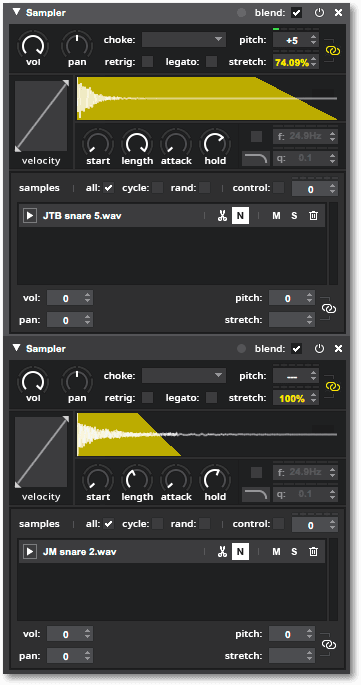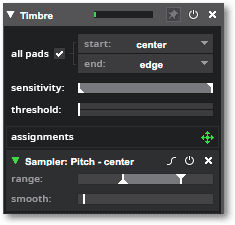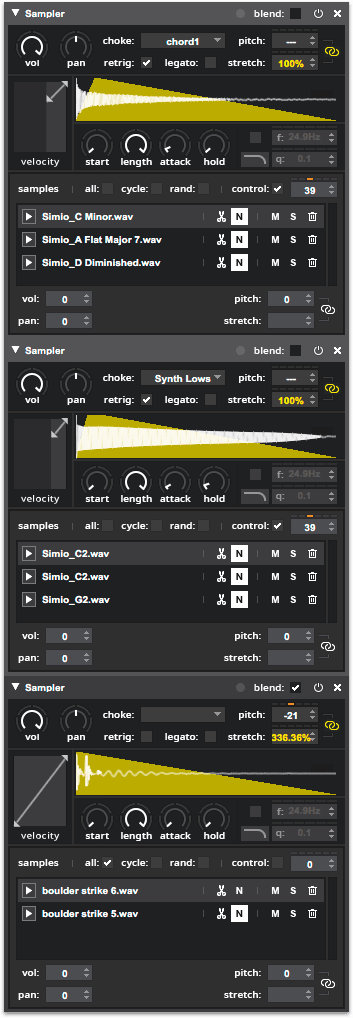This blog post is about Sensory Percussion version 1 and does not apply to the latest version 2 software included in the EVANS Hybrid Sensory Percussion bundle.

I consider it my main job as a drummer to provide a steady-groove with a solid backbeat. My next priority is to create a compelling composition with my groove, combining timbres and rhythms across the drums.
That's why when I build kits in Sensory Percussion I often stack multiple samplers on a single pad.
The sampler is a module in Sensory Percussion that plays and processes sound files. Typically one or more samplers are loaded onto a pad in SP that is tied to a musical gesture like “rimshot.” Audio files get loaded into that sampler, and sound every time you play that gesture. The sampler is really the engine that drives sound design in Sensory Percussion.
Wild FX with a Steady Backbeat
What's great about the sampler in Sensory Percussion is that you can stack as many of them as you want in any given pad. Stacking samplers is useful anytime you want multiple sounds on a single Sensory Percussion pad to behave independently of one another. For example, one sampler can have tonal sounds like chords that are in a choke group (so the tones don't overlap) and another sampler with percussive sounds not on a choke group.
When I stack samplers, I usually include at least one sampler that contains a sound drastically affected by a controller, and another sampler that sounds the same regardless of how you play. This technique allows me to create wild textures by playing between different zones, but also maintain a solid groove.
In the Instagram video embedded below, Tlacael is playing the Twin Cities kit that is included in our Themed Kits presets. You'll notice the pitch of the snare drum modulates up when he plays closer to the edge of the drum, but you'll also hear that another snare sound doesn't change pitch.

The screen-grab to the left shows the stacked-samplers on the center pad of the snare drum of the Twin Cities kit. The sampler pitch parameter (top right corner) of the sampler containing JTB snare 5.wav is controlled by a Center-to-Edge controller on channel one (pictured beneath it).
The sampler containing JM snare 2.wav isn't affected by any controllers, so its pitch will stay the same even if you play closer to the edge of the drum.

Combining Tonal and Percussive Sounds
The preset kit SIMIO is a great example of stacking samplers. It has rich tonal samples with percussive sounds layered underneath.
On the center pad of channels two and three (rack and floor mappings) of SIMIO there are three samplers. The first two samplers are synthesizer bass notes and chords. Their playback order is controlled by a center-to-edge timbre controller on each respective drum. That means that the chord changes depending on how close to the edge you play. These samplers also make use of the velocity input/output panel. They're set up so that you have to strike the drum at a high velocity to activate a chord, and harder still for the bass note to sound.

The bottom sampler is a composite sound of boulders being struck together. This sampler's pitch is determined by a center-to-edge controller. The closer you play to the edge, the higher pitch the boulder sounds become. This sampler's velocity i/o is in its default position, so the rock sounds will play when struck at any velocity. We built this kit to demonstrate how you can cleverly play underneath chords using Sensory Percussion.
The chords and the low notes are in separate choke groups so that they are cut off by their tonal counterparts on the opposite drum, but don't stifle each other (since they're on the same pad).
As you can see, there are tons of possibilities once you start stacking samplers. Being able to combine different kinds of sounds but keep their rule-systems separate is a powerful tool.
